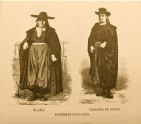
Clothing and names
"Mallorcan men generally wear the so-called gec or sayo over their vests. They’re such short jackets that you can see a part of their shirts between their vests and trousers. Something similar occurs with the guardapits (“breast protector”), cut obliquely towards the top. On one side they have a row of small buttons very close to each other, and, on the other, the corresponding buttonholes, but they always wear these jackets open.
However, the most notable item of clothing consists of the trousers, calçons amples or calçons amb bufes by name. They’re baggy trousers, in the Levantine style, but longer, reaching down to the calves, if not further. They’re tied at the bottom by a string or ribbon. They tend to be made of llista linen, cotton or a combination of both, and they’re made on Mallorca. They are generally dark blue in color with a white striped or light blue material with black stripes. However, wealthy farmers wear those trousers on Sundays but made of silk or a material mixing silk and cotton and imported from Catalonia or abroad. The not so wealthy wear printed cloth, with the same origin. The baggiest trousers are worn in Valldemossa, Estallencs, Pollença and, in general, the island’s entire mountainous area. In Lluc, the countryside and plains, however, these trousers tend to be longer and not as baggy. Under the trousers, particularly in winter, they wear the so-called, white calçons de davall, equally loose and made of local or foreign cotton or linen cloth.
For truly warm clothing, the most common item is the capot (“cape”), used not only by the wealthier classes but also with special fondness by the young. According to tastes, the cape can be complemented with a hood. Amongst wealthier men, it is made of more or less delicate black cloth, while humbler classes use a cape made from dark raw wool called burrell here and made on Mallorca. Many of these items are very thick, with a thread plush lining which is dyed scarlet red along the edges and in the hood. The pockets, by contrast, are outlined by a type of ornamental detail shaped like a broken blue and red line and forming a series of very sharp angles around the border."
Archduke Ludwig Salvator of Austria. Las Baleares por la palabra y el grabado. Majorca: General Part. Ed. Sa Nostra, Caja de Baleares. Palma de Mallorca. 1982.





















